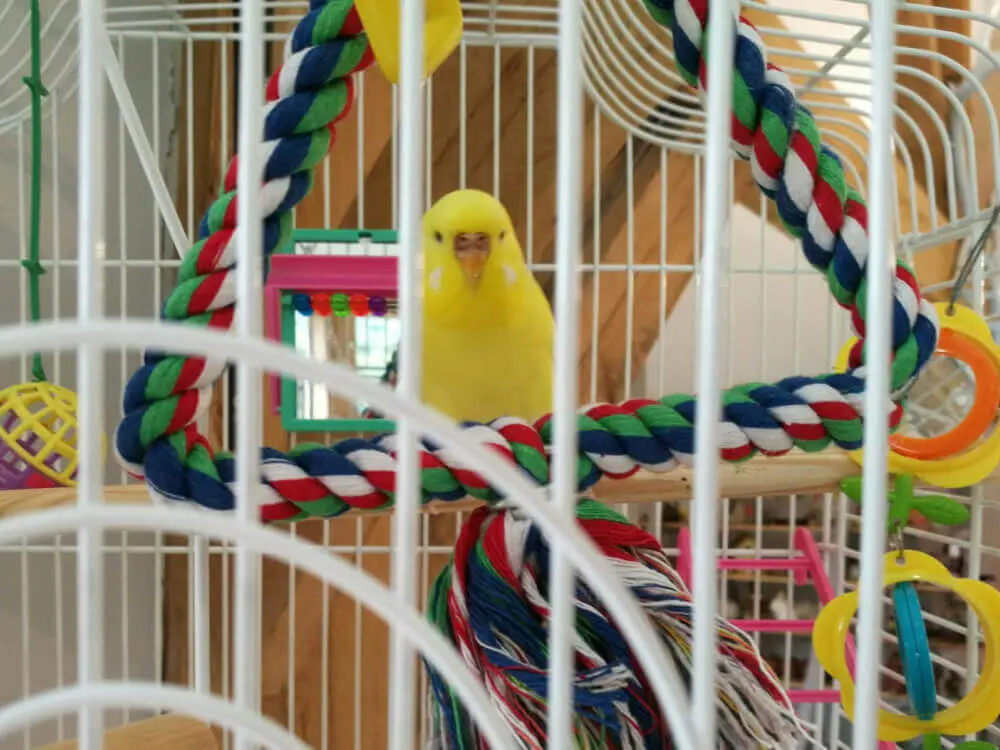Introduction
Setting up the perfect cage for your budgerigar, commonly known as a budgie, is crucial for their health, happiness, and overall well-being. Whether you’re a new budgie owner or looking to improve your current setup, understanding the best practices can make a significant difference. This guide on Budgerigar Cage Setup Tips will walk you through everything you need to know to create a comfortable and stimulating environment for your feathered friend.
Budgies are active and playful birds that require a well-thought-out cage arrangement to thrive. Choosing the right cage, incorporating essential accessories, and ensuring a safe and clean environment are just a few aspects we’ll cover. By the end of this post, you’ll have a clear idea of how to set up a budgie cage that meets all their needs, from perches and toys to feeding stations and more.
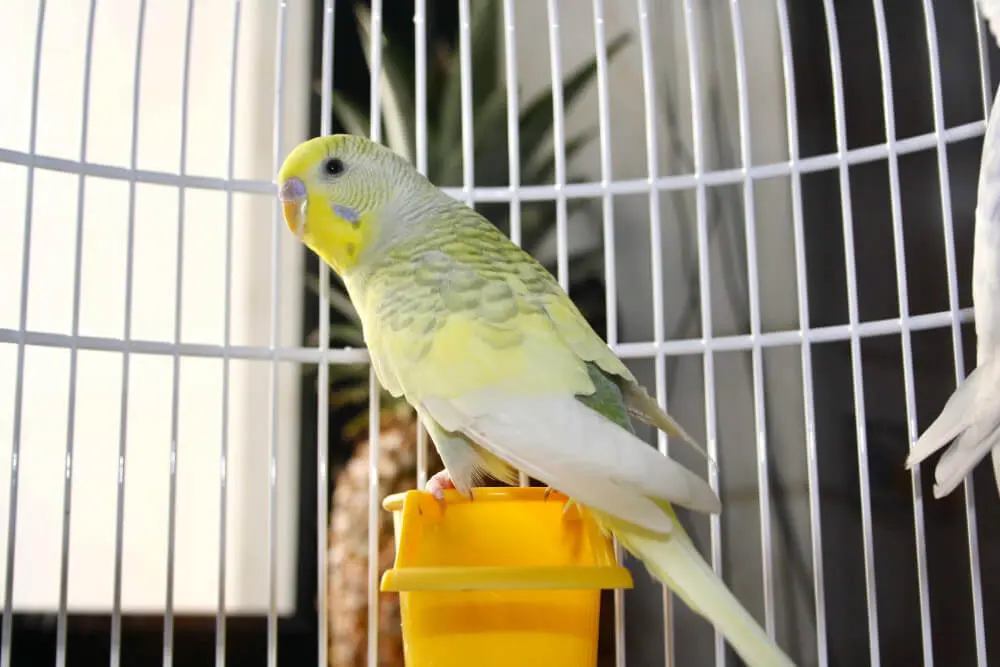
A budgerigar enjoying its time on a perch inside a spacious white cage.
In the following sections, we’ll dive into detailed tips and practical advice on how to set up your budgie’s cage. We’ll discuss the importance of cage size and placement, the best accessories to include, and how to keep the cage clean and safe. Whether you’re setting up a cage for the first time or looking to optimize your current setup, these budgerigar cage setup tips will help ensure your budgie lives a happy and healthy life.
Choosing the Right Cage for Your Budgerigar
Choosing the right cage for your budgerigar is the first and most important step in creating a comfortable and safe home for your feathered friend. The perfect cage setup ensures your budgie has enough space to fly, play, and explore. Here are some essential tips to help you pick the best cage for your budgie.
Cage Size and Shape
When it comes to budgie cages, bigger is always better. Budgies are active birds that need plenty of room to stretch their wings. A good rule of thumb is to select a cage that is at least 18 inches wide, 18 inches deep, and 24 inches high. Horizontal space is more important than vertical space because budgies love to fly back and forth. Look for a cage with more width and length to give your budgie the space it needs.
Bar Spacing
Bar spacing is a critical factor in ensuring your budgie’s safety. The bars should be spaced no more than 1/2 inch apart to prevent your budgie from squeezing through or getting stuck. This will keep your budgie safe and secure inside the cage.
Cage Material and Construction
The cage material should be sturdy and non-toxic. Stainless steel is an excellent choice as it is durable, easy to clean, and rust-resistant. Avoid cages with lead or zinc, as these materials can be harmful to your budgie. Make sure the cage has a secure door latch to keep your budgie safely inside.
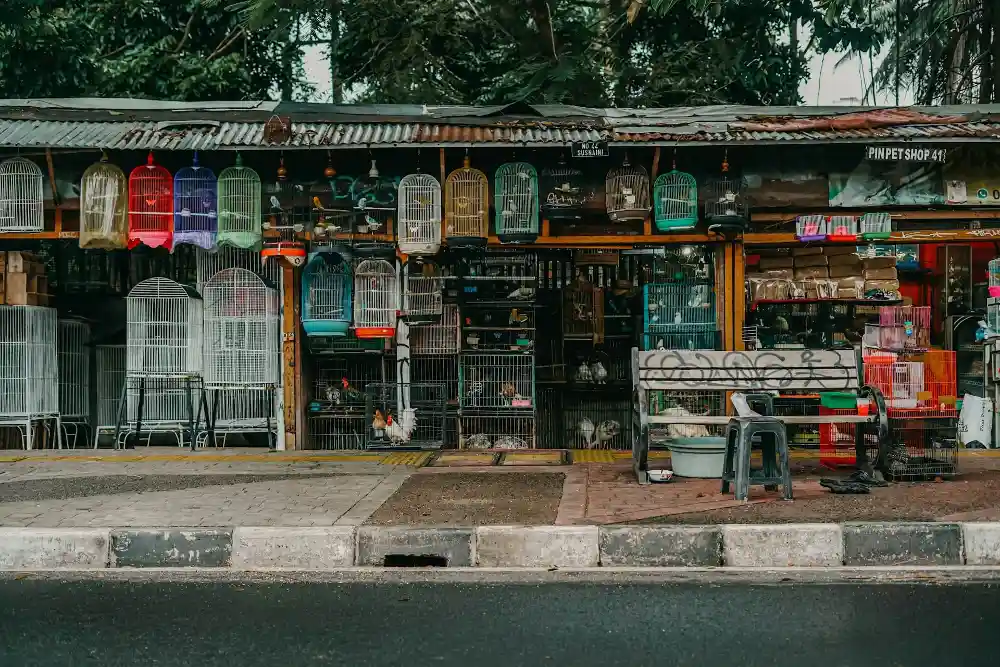
A selection of different types of budgerigar cages available in a pet store.
Ease of Cleaning
A clean cage is essential for your budgie’s health. Look for a cage with a removable tray at the bottom, making it easier to clean droppings and old food. Cages with wide doors allow better access to the interior for thorough cleaning.
Additional Features
Consider a cage with additional features like multiple perches, food and water dish holders, and space for toys. These features make it easier to set up a stimulating environment for your budgie, keeping them entertained and happy.
By following these tips for choosing the right cage, you’ll create a safe and comfortable home for your budgerigar. A spacious, well-constructed, and easy-to-clean cage with appropriate bar spacing will ensure your budgie has everything it needs to live a healthy and joyful life.
Essential Cage Accessories for Budgerigars
Outfitting your budgerigar’s cage with the right accessories is key to keeping them healthy, happy, and engaged. The right accessories provide mental stimulation, physical exercise, and comfort. Here are some must-have cage accessories for your budgie:
Perches
Perches are essential for your budgie’s feet health and exercise. Provide a variety of perches made from different materials like wood, rope, and natural branches. This variety helps prevent foot problems and keeps your budgie entertained. Ensure that the perches are of different diameters to mimic the natural environment and promote foot exercise.
Food and Water Dishes
Sturdy, easy-to-clean food and water dishes are a must. Place them in an accessible location within the cage. It’s a good idea to have at least two food dishes—one for seeds or pellets and one for fresh fruits and vegetables. Make sure to clean these dishes daily to prevent bacterial growth and ensure your budgie always has fresh food and water.
Toys
Budgies are playful birds that need mental stimulation. Provide a variety of toys, including bells, mirrors, and chew toys. Rotate the toys regularly to keep your budgie interested and engaged. Toys not only prevent boredom but also help in maintaining your budgie’s beak health by providing something to chew on.
Swings and Ladders
Swings and ladders are excellent for adding some fun and exercise to your budgie’s daily routine. They love to climb and swing, which helps in developing their muscles and coordination. Place these accessories at different heights to encourage your budgie to move around and explore.

An example of an enriched budgerigar cage setup with various accessories, perches, toys, and food dishes.
Nesting Box or Tent
A cozy nesting box or tent provides your budgie with a sense of security and a place to rest. While budgies don’t typically use nests for sleeping, they do appreciate having a small, enclosed space to retreat to when they feel the need.
Bathing Dish
Budgies enjoy bathing to keep their feathers clean and healthy. Provide a shallow dish of water in the cage or attach a birdbath to the cage. Ensure the water is clean and change it regularly. Some budgies also enjoy misting with a spray bottle, so this can be another option to consider.
Cuttlebone and Mineral Blocks
Cuttlebones and mineral blocks are essential for your budgie’s beak maintenance and calcium intake. These items help keep their beak trimmed and provide necessary nutrients. Attach them securely to the cage and monitor your budgie’s usage.
By incorporating these essential cage accessories, you can create a stimulating and comfortable environment for your budgerigar. A well-equipped cage not only promotes physical and mental well-being but also ensures your budgie remains happy and entertained.
Placement and Environment Considerations
The placement of your budgerigar’s cage plays a crucial role in their overall well-being. A well-chosen location can ensure your budgie feels secure, engaged, and comfortable. Here are some essential tips for choosing the best spot for your budgerigar’s cage:
Optimal Location
Place the cage in an area where your budgie can be part of the family’s daily activities but still have a quiet place to retreat when needed. A living room or family room is often a good choice, as it allows your budgie to interact and feel included without being overwhelmed by constant activity.

A green budgerigar cage strategically placed in a cozy living room environment.
Avoid Drafts and Direct Sunlight
Budgies are sensitive to temperature changes and drafts. Avoid placing the cage near windows, doors, or air conditioning vents where sudden drafts can occur. Similarly, avoid direct sunlight as it can overheat the cage. Instead, provide indirect natural light which is beneficial for their health and well-being.
Stable Temperature
Budgerigars thrive in a stable environment with consistent temperatures. Keep the cage in a room where the temperature stays between 65-75°F (18-24°C). Avoid placing the cage in the kitchen or bathroom, where temperature and humidity levels can fluctuate dramatically.
Quiet and Calm Environment
While budgies enjoy social interaction, they also need periods of quiet and calm. Ensure the cage is in a spot where your budgie can have downtime, away from loud noises like TVs, radios, or frequent loud conversations. This balance helps prevent stress and promotes better health.
Elevation of the Cage
Budgies feel safer when their cage is elevated off the ground. Position the cage at eye level or slightly higher to make your budgie feel secure. A cage stand or a sturdy table can be used to achieve the right height.
Safe and Non-Toxic Surroundings
Ensure the area around the cage is free from potential hazards. Keep toxic plants, chemicals, and other harmful items out of reach. Budgies are curious and may chew on things they shouldn’t, so it’s important to make their environment as safe as possible.
Social Interaction
Place the cage where your budgie can see and hear you. Budgies are social creatures and enjoy being around people. Regular interaction helps them stay happy and prevents loneliness. Talk to your budgie and let them be a part of your daily routine.
Night time Considerations
Budgies need a good night’s sleep to stay healthy. Cover the cage at night with a breathable cloth to give your budgie a sense of security and ensure they get uninterrupted sleep. Make sure the cover doesn’t restrict airflow and the room remains at a comfortable temperature.
By carefully considering the placement and environment of your budgerigar’s cage, you can create a safe, comfortable, and stimulating home for your feathered friend. A well-chosen location helps your budgie feel secure and engaged, contributing to their overall happiness and health.
Cage Cleaning and Maintenance Tips
Maintaining a clean and hygienic cage is vital for your budgerigar’s health and well-being. Regular cleaning prevents the buildup of harmful bacteria and keeps your budgie happy and healthy. Here are some practical cage cleaning and maintenance tips to help you keep your budgerigar’s environment spotless:
Daily Cleaning Routine
To ensure your budgerigar’s cage remains clean, establish a daily cleaning routine. Remove uneaten food, especially fresh fruits and vegetables, to prevent mold and bacterial growth. Change the water in the dish daily to provide fresh, clean drinking water. Wipe down perches and toys with a damp cloth to remove droppings and debris.
Weekly Deep Cleaning
A more thorough cleaning should be done weekly. Start by removing your budgie and placing them in a safe temporary cage or play area. Take out all accessories, including perches, toys, and dishes. Wash these items with warm water and mild soap, then rinse thoroughly to remove any soap residue.
For the cage itself, use a bird-safe cleaner or a mixture of water and white vinegar to wipe down the bars and base. Avoid using harsh chemicals or cleaners that can be toxic to your budgie. Pay special attention to areas where droppings and food particles tend to accumulate.
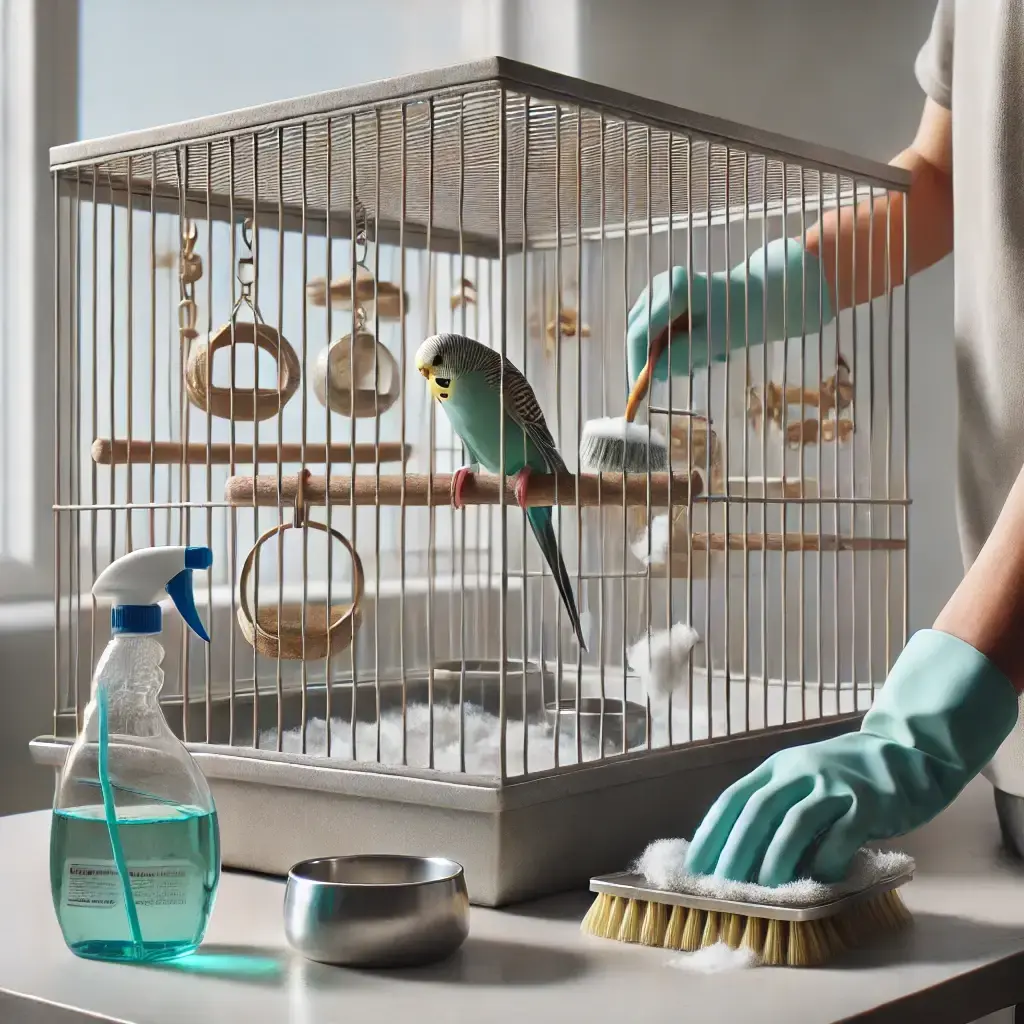
Maintaining a clean cage is crucial for a budgerigar’s health, as shown by a person cleaning a cage.
Monthly Maintenance
Once a month, give the cage a deep clean to ensure it remains in top condition. Disassemble the cage if possible, and soak all parts in warm soapy water. Use a brush to scrub away any stubborn grime. Rinse all parts thoroughly and let them dry completely before reassembling the cage.
Lining the Cage
Line the bottom of the cage with newspaper or bird-safe paper liners. This makes it easier to clean up droppings and food debris. Replace the liner daily or as needed to maintain cleanliness. Avoid using materials like sandpaper, which can harm your budgie’s feet.
Managing Odors
To keep odors at bay, ensure the cage is well-ventilated. Regular cleaning and the use of bird-safe air purifiers can help manage any unpleasant smells. Avoid using scented sprays or deodorizers, as these can be harmful to your budgie’s respiratory system.
Inspecting for Wear and Tear
Regularly inspect the cage and accessories for signs of wear and tear. Check for rust, loose bars, or any sharp edges that could harm your budgie. Replace damaged perches, toys, or any other accessories to maintain a safe environment.
Keeping the Area Around the Cage Clean
The area around the cage can also get messy. Sweep or vacuum regularly to pick up fallen seeds, feathers, and other debris. This helps maintain a clean and pleasant environment for both you and your budgie.
By following these cage cleaning and maintenance tips, you’ll create a healthier and more comfortable living space for your budgerigar. Regular cleaning routines, coupled with occasional deep cleans, ensure your budgie’s cage remains a safe and hygienic home.
Setting Up Perches and Toys for Enrichment
Creating an enriching environment for your budgerigar is essential for their mental and physical health. Setting up the right perches and toys can keep your budgie entertained, active, and happy. Here’s how to set up perches and toys to maximize enrichment in your budgerigar’s cage:
Choosing the Right Perches
Perches are not just for resting; they play a crucial role in your budgie’s exercise and foot health. Here are some tips for selecting and arranging perches:
1. Variety of Materials: Use a mix of natural wood, rope, and plastic perches. Natural wood perches are great for their feet and help wear down their nails. Rope perches provide a different texture and can be more comfortable for resting.
2. Different Diameters: Provide perches of varying diameters to mimic natural branches. This variation prevents foot fatigue and promotes healthy foot muscles.
3. Placement: Place perches at different heights and angles within the cage. This encourages climbing and movement, which is essential for your budgie’s exercise. Ensure there is enough space between perches to prevent overcrowding and allow free movement.
4. Avoid Sandpaper Perches: Sandpaper perches can be harmful to your budgie’s feet, causing sores and discomfort. Stick to natural and smooth perches for the best results.
Selecting Engaging Toys
Toys are vital for mental stimulation and preventing boredom in budgerigars. Here’s how to choose and place toys effectively:
1. Variety of Toys: Provide a variety of toys such as bells, mirrors, and chew toys. Budgies enjoy different textures and sounds, which keep them entertained.
2. Rotating Toys: Rotate toys regularly to keep things fresh and exciting for your budgie. This prevents boredom and keeps your budgie engaged.
3. Interactive Toys: Include interactive toys that require your budgie to solve puzzles or manipulate objects. These toys stimulate their mind and can help prevent behavioral issues caused by boredom.
4. Safe Materials: Ensure all toys are made from bird-safe materials. Avoid toys with small parts that can be swallowed or those made from toxic materials.
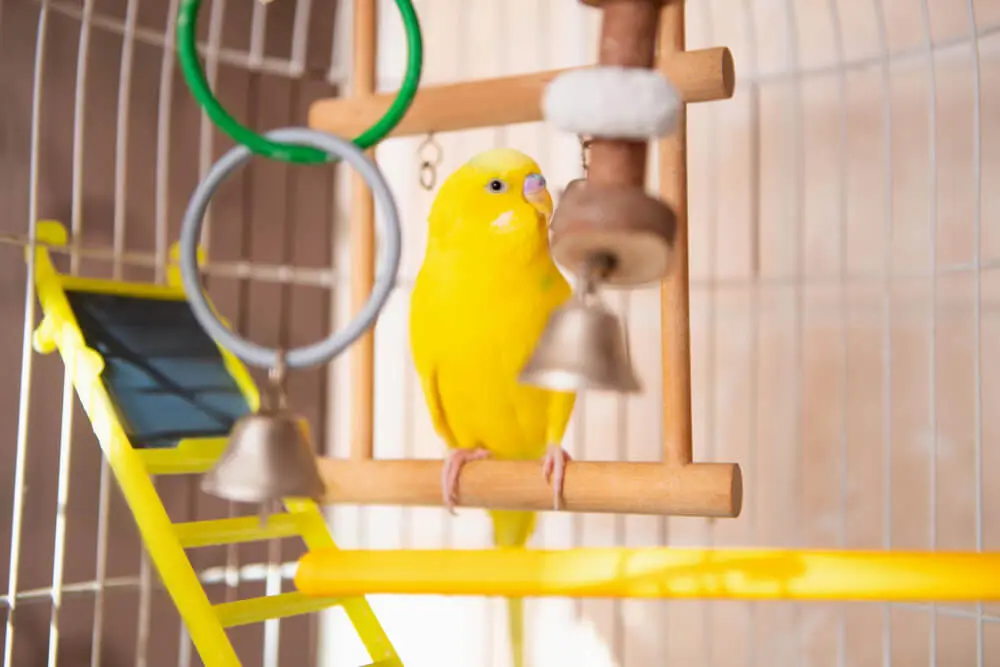
A well-arranged budgerigar cage featuring perches and engaging toys.
Creating a Stimulating Environment
A well-arranged cage with perches and toys can significantly enhance your budgie’s quality of life. Here are additional tips for creating a stimulating environment:
1. Perch Placement: Place perches near food and water dishes, and around the cage at various heights to encourage movement. Ensure there is a perch near the cage door for easy access.
2. Foraging Opportunities: Incorporate foraging toys that allow your budgie to search for treats. This mimics natural behaviors and provides mental stimulation.
3. Play Area Outside the Cage: If possible, set up a play area outside the cage with additional perches and toys. Supervised playtime outside the cage provides extra enrichment and exercise.
4. Personal Space: Ensure there are areas in the cage where your budgie can retreat for some quiet time. This balance between stimulation and rest is important for their well-being.
By setting up perches and toys thoughtfully, you can create an enriching environment that keeps your budgerigar healthy and happy. A variety of perches and engaging toys will ensure your budgie is mentally stimulated and physically active, leading to a happier, healthier bird.
Feeding Stations: Food and Water Setup
Setting up effective feeding stations in your budgerigar’s cage is crucial for their nutrition and overall health. A well-organized food and water setup ensures your budgie always has access to fresh, clean sustenance. Here are some essential tips for creating optimal feeding stations for your budgerigar:
Choosing the Right Food and Water Dishes
1. Material Matters: Opt for sturdy, non-toxic materials like stainless steel or ceramic for food and water dishes. These materials are durable, easy to clean, and safe for your budgie.
2. Avoid Plastic: Plastic dishes can harbor bacteria and are more prone to damage, which can create sharp edges. If you do use plastic, ensure it is high-quality and inspect it regularly for any signs of wear.
3. Secure Attachment: Choose dishes that can be securely attached to the cage bars. This prevents spills and keeps the feeding area clean. Some dishes come with built-in clamps or hooks for easy attachment.

Ensuring your budgerigar has easy access to food and water, as shown by this well-setup cage.
Placement of Food and Water Dishes
1. Accessibility: Place food and water dishes in easily accessible locations within the cage. Ensure your budgie can reach them without any difficulty. Consider placing them at mid-height in the cage, away from perches to prevent contamination from droppings.
2. Separation: Keep food and water dishes separate from each other to avoid contamination. This also encourages your budgie to move around the cage, providing a bit of exercise.
3. Multiple Stations: If you have more than one budgie, consider having multiple feeding stations. This prevents competition and ensures all birds have access to food and water.
Keeping Food Fresh and Clean
1. Daily Cleaning: Clean food and water dishes daily to prevent bacterial growth and contamination. Use warm, soapy water and rinse thoroughly before refilling.
2. Fresh Water: Change the water at least once a day. Budgies can be messy drinkers, so more frequent changes might be necessary to ensure the water stays clean.
3. Fresh Food: Provide a mix of seeds, pellets, and fresh fruits and vegetables. Remove any uneaten fresh food after a few hours to prevent spoilage and bacterial growth.
Foraging and Enrichment
1. Foraging Opportunities: Incorporate foraging toys and treat dispensers into your budgie’s feeding routine. This stimulates natural behaviors and provides mental enrichment. Hide small amounts of food in different parts of the cage to encourage exploration.
2. Treats: Offer treats like millet sprays or cuttlebones occasionally. These can be placed near perches or clipped to the cage bars to make feeding time more engaging.
Monitoring and Adjustments
1. Observe Eating Habits: Keep an eye on your budgie’s eating and drinking habits. Changes in appetite or behavior can indicate health issues. Ensure they are eating a balanced diet and drinking enough water.
2. Adjust as Needed: If you notice your budgie struggling to access food or water, adjust the placement of the dishes. Ensure the setup is convenient and comfortable for your bird.
By setting up effective feeding stations, you can ensure your budgerigar has easy access to fresh food and water, promoting their health and well-being. A thoughtful food and water setup not only keeps your budgie nourished but also enhances their overall living environment.
Ensuring Safety and Comfort in the Cage
Creating a safe and comfortable environment in your budgerigar’s cage is essential for their well-being. Ensuring safety and comfort involves careful selection of cage materials, proper placement of accessories, and regular maintenance. Here’s how you can make your budgerigar’s cage a secure and cozy home:
Safe Cage Materials
1. Non-Toxic Materials: Choose a cage made from non-toxic materials like stainless steel. Avoid cages with paint or coatings that can chip off and be ingested by your budgie, as these can be harmful.
2. Sturdy Construction: Ensure the cage is well-constructed with secure doors and no sharp edges. A sturdy cage prevents accidents and keeps your budgie safe.
Proper Bar Spacing
1. Prevent Escapes: The bars of the cage should be spaced no more than 1/2 inch apart. This prevents your budgie from squeezing through the bars or getting stuck, ensuring they stay safely inside the cage.
2. Avoid Wide Gaps: Check for any wide gaps or openings in the cage where your budgie might get trapped. Secure these areas to prevent any accidents.
Comfortable Perches
1. Variety of Perches: Provide a variety of perches made from natural wood, rope, and other safe materials. Different textures and sizes help keep your budgie’s feet healthy and comfortable.
2. Proper Placement: Place perches at different heights and locations within the cage. Ensure they are not positioned directly above food and water dishes to prevent contamination.
Cozy Sleeping Area
1. Sleeping Perch: Designate a specific perch for sleeping, ideally positioned in a quiet and darker part of the cage. This helps your budgie establish a regular sleeping routine.
2. Nesting Box or Tent: Consider adding a small nesting box or tent for your budgie to retreat to. While not used for nesting, these provide a sense of security and a place to rest.
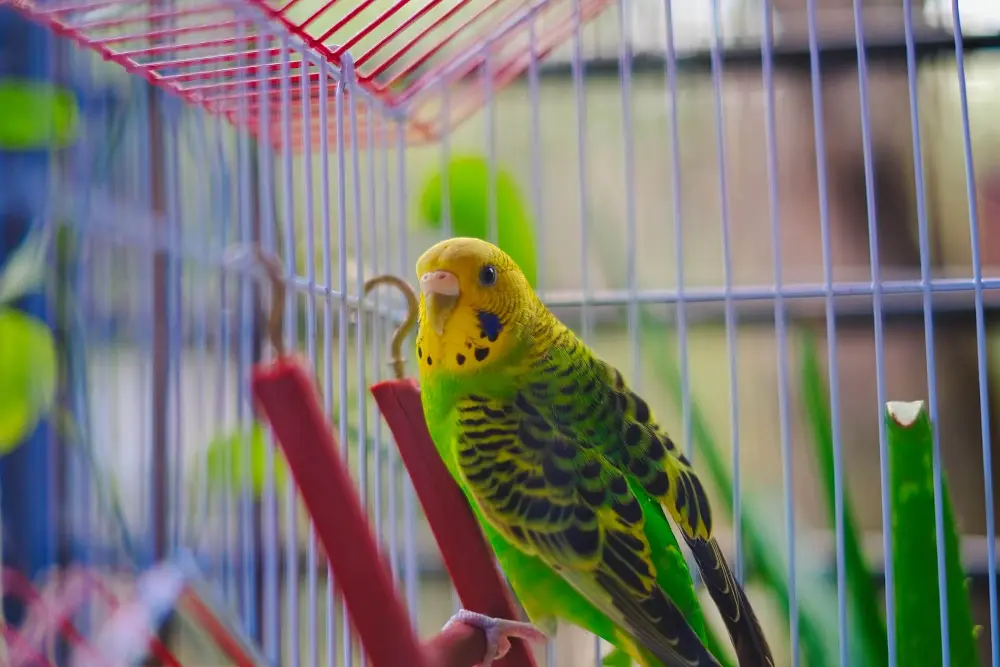
A yellow and green budgerigar enjoying a safe and comfortable cage environment.
Temperature and Humidity Control
1. Stable Environment: Keep the cage in a room with a stable temperature between 65-75°F (18-24°C). Avoid placing the cage near windows, doors, or air conditioning vents to prevent drafts and sudden temperature changes.
2. Humidity Levels: Maintain moderate humidity levels in the room. Budgies are comfortable in humidity levels between 40-60%. Use a humidifier if necessary to keep the environment stable.
Regular Maintenance
1. Cleanliness: Regularly clean the cage, perches, and accessories to prevent the buildup of bacteria and debris. A clean cage is crucial for your budgie’s health and comfort.
2. Inspect for Damage: Frequently check the cage for any signs of wear and tear. Repair or replace damaged parts to prevent injuries.
Safe Toys and Accessories
1. Non-Toxic Toys: Choose toys made from safe, non-toxic materials. Avoid toys with small parts that can be swallowed or sharp edges that can cause injuries.
2. Proper Placement: Ensure toys are securely attached to the cage and placed in locations that encourage movement and play without overcrowding the space.
Stress Reduction
1. Quiet Time: Provide a quiet and calm environment for your budgie, especially at night. Cover the cage with a breathable cloth to help your budgie feel secure and get a good night’s sleep.
2. Social Interaction: Spend time interacting with your budgie daily. Social interaction helps reduce stress and promotes a strong bond between you and your bird.
By focusing on these aspects, you can ensure that your budgerigar’s cage is a safe and comfortable sanctuary. A well-maintained, thoughtfully arranged cage contributes significantly to your budgie’s happiness and overall health.
Common Mistakes to Avoid in Budgerigar Cage Setup
Setting up a budgerigar cage might seem straightforward, but there are common mistakes that can impact your budgie’s health and happiness. By being aware of these pitfalls, you can create a safe and stimulating environment for your feathered friend. Here are some common mistakes to avoid in budgerigar cage setup:
Choosing the Wrong Cage Size
Too Small: One of the biggest mistakes is choosing a cage that is too small. Budgies need space to fly and move around. A cage that is too cramped can lead to stress and health issues. Always opt for the largest cage you can accommodate.
Improper Bar Spacing
Too Wide: Bars that are spaced too widely can allow your budgie to escape or get stuck. Ensure the bar spacing is no more than 1/2 inch to keep your budgie safe and secure.
Neglecting Variety in Perches
Uniform Perches: Using perches of the same size and material can lead to foot problems. Provide a variety of perches with different textures and diameters to promote foot health and prevent sores.
Inadequate Cleaning
Irregular Cleaning: Not cleaning the cage regularly can result in the buildup of bacteria and mold, which can make your budgie sick. Establish a regular cleaning routine to maintain a hygienic environment.
Poor Placement of Food and Water Dishes
Inaccessible Dishes: Placing food and water dishes in hard-to-reach areas can discourage your budgie from eating and drinking. Ensure dishes are easily accessible and kept clean.
Overcrowding the Cage
Too Many Toys and Perches: While toys and perches are important, overcrowding the cage can restrict your budgie’s movement. Leave enough open space for your budgie to fly and explore.
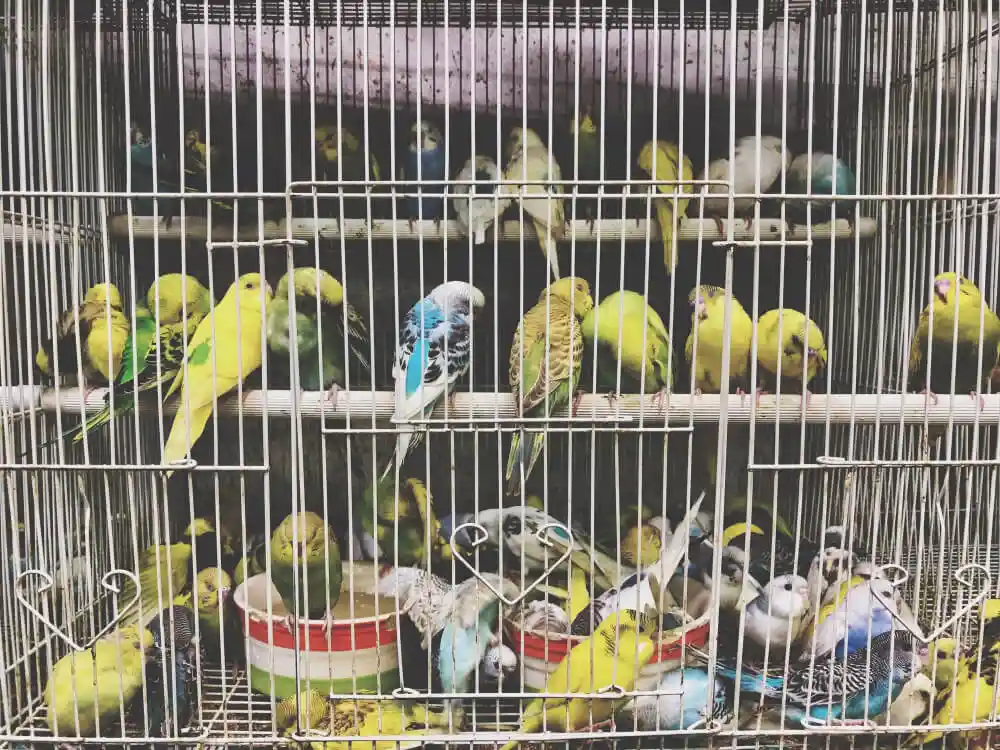
An overcrowded cage illustrating common mistakes in budgerigar cage setup.
Ignoring Environmental Factors
Drafts and Direct Sunlight: Placing the cage in a drafty area or direct sunlight can cause temperature fluctuations that stress your budgie. Choose a stable, well-lit area away from drafts and direct sun.
Lack of Mental Stimulation
Few Toys and Activities: Budgies are intelligent and need mental stimulation. Not providing enough toys or rotating them regularly can lead to boredom and behavioral issues. Keep a variety of toys and change them frequently.
Unsafe Cage Materials
Toxic Materials: Using cages or accessories made from toxic materials can harm your budgie. Ensure everything in the cage is made from bird-safe, non-toxic materials.
Ignoring Social Interaction
Lack of Interaction: Budgies are social birds and need regular interaction. Ignoring your budgie can lead to loneliness and depression. Spend time talking to and playing with your budgie daily.
Improper Cage Covering at Night
Complete Darkness or Light Exposure: Covering the cage completely or not at all can disrupt your budgie’s sleep. Use a breathable cloth to cover the cage partially, providing a sense of security while allowing some airflow.
By avoiding these common mistakes in budgerigar cage setup, you can ensure your budgie has a safe, comfortable, and stimulating environment. A well-thought-out cage setup contributes significantly to your budgie’s physical and mental well-being, leading to a happier and healthier bird.
Frequently Asked Questions (FAQs)
1. What size cage is best for a budgerigar? A cage for a single budgerigar should be at least 18x18x18 inches, but larger is always better. If you have multiple budgies, ensure the cage is spacious enough to allow them to fly and move comfortably.
2. How many perches should be in a budgerigar cage? Provide multiple perches of varying diameters and materials to help keep your budgie’s feet healthy. Natural wood perches are a great choice.
3. What type of bedding should I use in a budgerigar cage? Use paper-based bedding or newspaper for easy cleaning and to avoid respiratory issues. Avoid sandpaper and wood shavings, which can be harmful.
4. How often should I clean my budgerigar’s cage? Spot clean the cage daily by removing droppings and leftover food. Perform a thorough cleaning once a week by washing the cage, perches, and toys with a bird-safe cleaner.
5. What toys are suitable for budgerigars? Budgerigars enjoy toys that encourage chewing, climbing, and swinging. Include toys made of natural materials like wood and sisal, and rotate them regularly to keep your bird engaged.
6. Can I place my budgerigar’s cage near a window? Placing the cage near a window can be stimulating for your budgie, but ensure it is not in direct sunlight or exposed to drafts. Monitor the temperature and light to keep your bird comfortable.
7. How do I provide a balanced diet for my budgerigar? Offer a variety of foods including high-quality budgie pellets, fresh vegetables, fruits, and occasional seeds. Avoid avocado, chocolate, caffeine, and alcohol, as these are toxic to birds.
8. Should I cover my budgerigar’s cage at night? Covering the cage at night can help your budgie feel secure and promote better sleep. Use a breathable fabric and ensure there is adequate ventilation.
9. How can I make my budgerigar feel comfortable in its new cage? Introduce your budgie to its new cage gradually. Provide familiar toys and perches, and ensure the cage is placed in a quiet area where your bird can observe household activities without feeling stressed.
10. What should I do if my budgerigar seems stressed or unhappy in its cage? Ensure your budgie has enough mental and physical stimulation. Offer a variety of toys, spend time interacting with your bird, and consider providing a larger cage if necessary. If stress persists, consult an avian veterinarian.
Conclusion
Setting up the perfect cage for your budgerigar involves thoughtful planning and attention to detail. By following these Budgerigar Cage Setup Tips, you can create a safe, comfortable, and stimulating environment for your feathered friend.
Choosing the right cage, outfitting it with essential accessories, and ensuring a clean and safe environment are critical steps. Remember to provide a variety of perches and engaging toys to keep your budgie entertained and healthy. Proper placement of food and water dishes ensures your budgie has easy access to fresh sustenance. Paying attention to cage placement and environmental factors can significantly enhance your budgie’s quality of life.
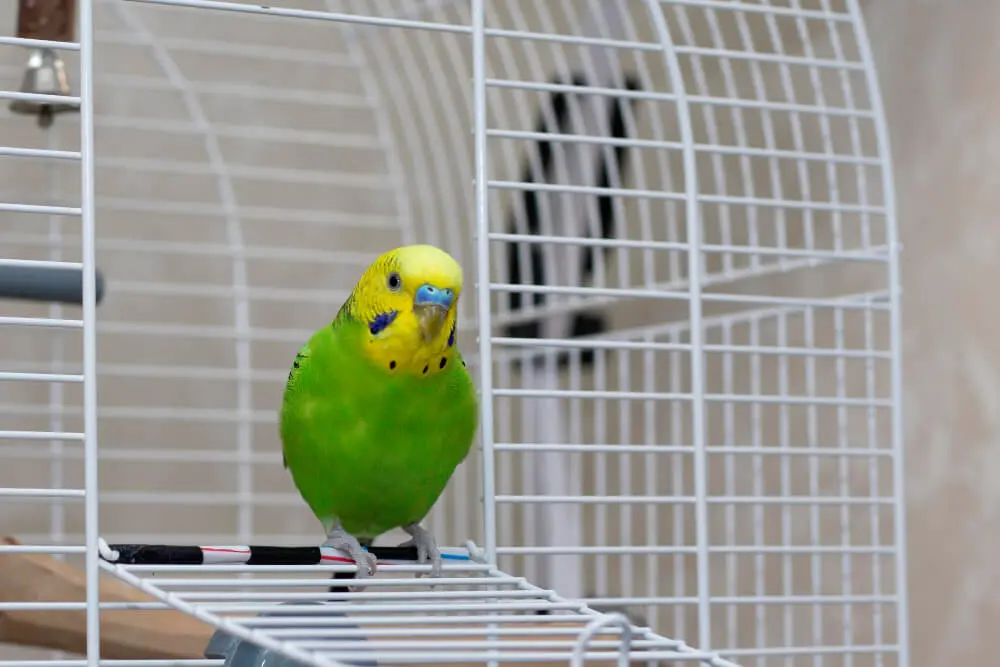
A green budgerigar enjoying its time in a well-organized and clean cage.
Avoid common mistakes such as using the wrong cage size, improper bar spacing, and neglecting regular cleaning. By addressing these potential pitfalls, you can ensure your budgie’s safety and comfort.
Creating a nurturing home for your budgerigar not only promotes their physical well-being but also supports their mental health. A happy and healthy budgie is more likely to thrive, providing you with joy and companionship. With these tips, you’re well on your way to becoming an expert in budgerigar care, ensuring your pet has a fulfilling and enriched life.

